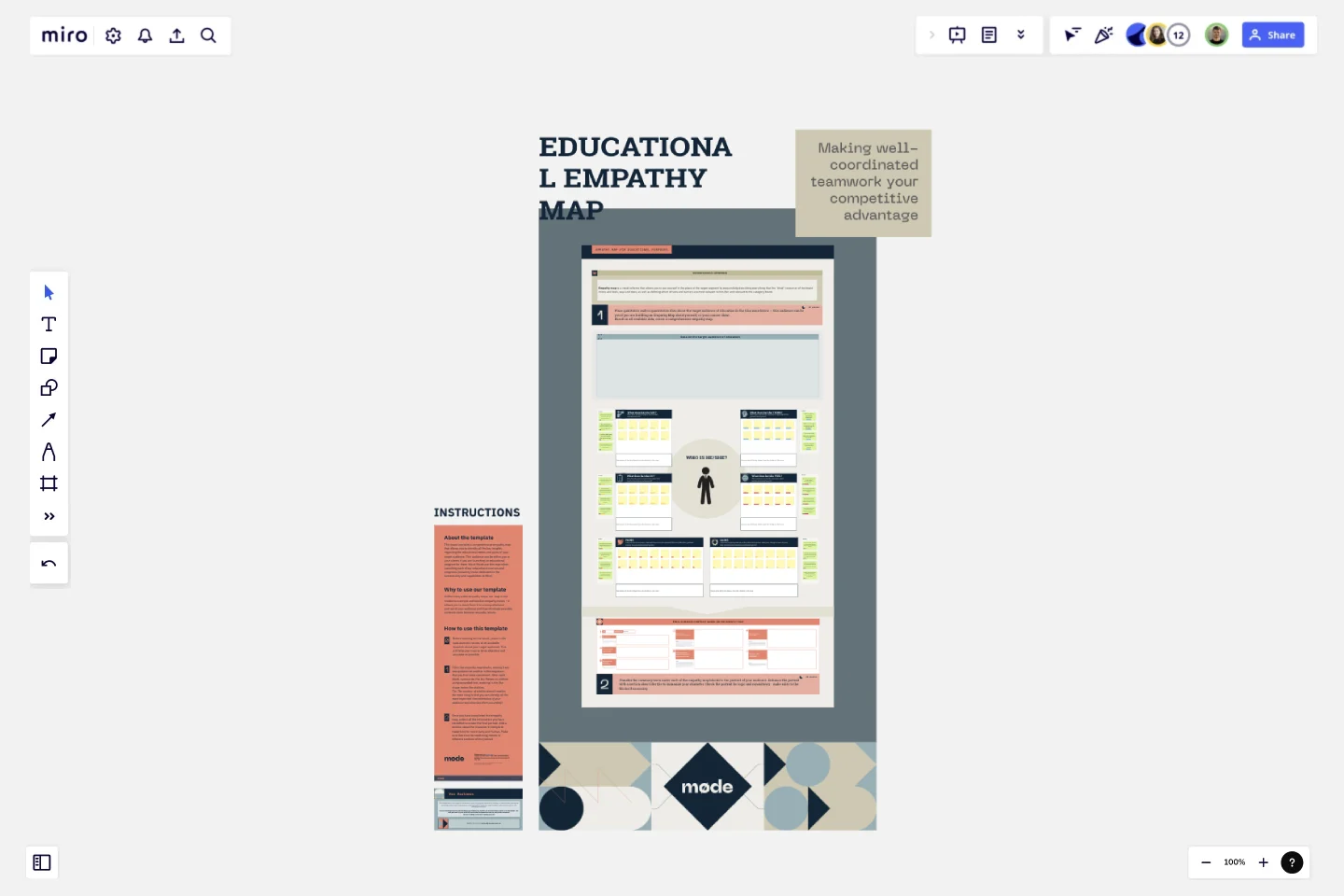Empathy Map for Educational Purposes
This board contains a comprehensive empathy map that allows you to identify all the key insights regarding the educational needs and pains of your target audience.
This audience can be either you or your clients if you are launching an educational program for them. We at Mode use this map when launching each of our educational courses and programs (including those dedicated to the functionality and capabilities of Miro).
Why to use our template
Unlike many other empathy maps, our map is not limited to a simple and familiar empathy matrix - it allows you to move from it to a comprehensive portrait of your audience and thus eliminate possible contradictions between empathy blocks.
How to use this template
Before working on the board, place in the data zone the results of all available research about your target audience. This will help your map to be as objective and accurate as possible.
Fill in the empathy map blocks, moving from one question to another in the sequence that you find most convenient. After each block, summarize the key theses on stickies using expanded text, entering it into the shape below the stickies.Tip: The number of stickies doesn't matter: the main thing is that you can identify all the most important characteristics of your audience and describe them accurately!
Once you have completed the empathy map, collect all the information you have identified to create the final portrait. Add a section about the character's lifestyle to make him/her more lively and human. Make sure there are no conflicting details in different sections of the portrait.
This template was created by Mode team.
Get started with this template right now.
Product Backlog Template
Works best for:
Agile Methodology, Kanban Boards, Product Management
Development teams are often juggling many products at once. A product backlog is a project management tool that helps teams keep track of projects in flight as they build and iterate, so you can store everyone's ideas, plan epics, and prioritize tasks. The highest-priority tasks are at the top of the product backlog, so your team knows what to work on first. Product backlogs make it easier for teams to plan and allocate resources, but it also provides a single source of truth for everyone to know what development teams are working on.
A3 Report Template
Works best for:
Product, Strategy and Planning
The A3 report template is a carefully designed tool that provides teams with a structured and visual methodology to tackle challenges. It divides the problem-solving process into background, current context, data analysis, and implementation plans, ensuring a comprehensive approach to each issue. One of the major advantages of this template is its "Data Analysis" section, which enables teams to delve deeply into concrete insights and trends. This data-driven approach ensures that all recommendations and actions are based on real, tangible evidence rather than just intuition, leading to more effective and strategic decision-making.
The Product Storyboard
Works best for:
Product Management, Planning
The Product Storyboard template enables product managers to visualize product experiences and user journeys. By mapping out key touchpoints, interactions, and scenarios, this template helps teams understand user needs and pain points. With sections for defining user personas, storyboarding user flows, and capturing feedback, it supports iterative product design and validation. This template serves as a storytelling tool for communicating product visions and guiding product development efforts towards delivering exceptional user experiences.
Website Wireframing Template
Works best for:
Wireframes, User Experience
Wireframing is a method for designing a website at the structural level. A wireframe is a stylized layout of a web page showcasing the interface elements on each page. Use this Wireframe Template to iterate on web pages quickly and cheaply. You can share the wireframe with clients or teammates and collaborate with stakeholders. Wireframes allow teams to get stakeholder buy-in without investing too much time or resources. They help ensure that your website’s structure and flow will meet user needs and expectations.
Define Your Product's Target Audience
Works best for:
Product Management, Planning
Too broad an audience? Or trying to target too many audiences? This is a certain path to product failure.
PRD Template
Works best for:
Product Development, Product , Management
The PRD Template by Miro is a blueprint designed to streamline the product development process. Acting as a central hub for all essential details, this template ensures team alignment by laying out clear project objectives, use cases, and design specifics. The primary benefit? Seamless communication and clarity, reducing the likelihood of missteps and fostering a smooth transition from idea conception to product launch.
